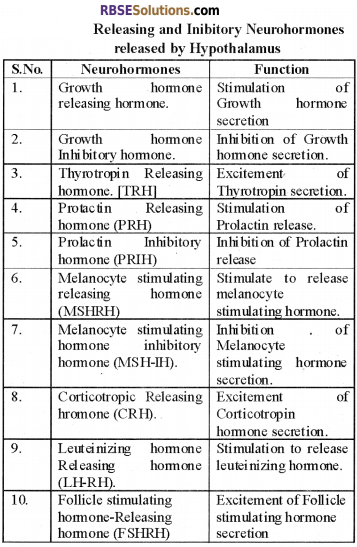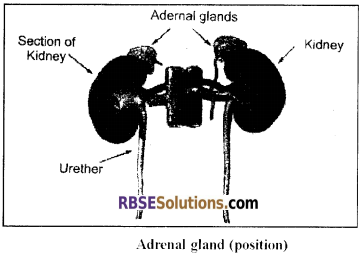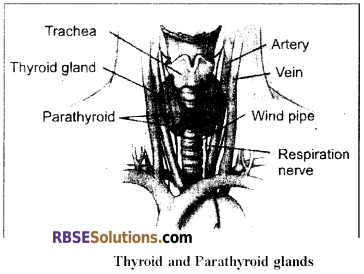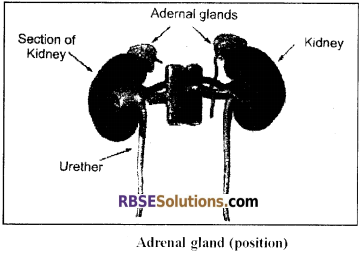Rajasthan Board RBSE Class 12 Biology Chapter 29 Man-Chemical Coordination
RBSE Class 12 Biology Chapter 29 Multiple Choice Questions
Question 1.
Secretions of endocrine glands are called:
(a) Pheromone
(b) Enzyme
(c) Hormone
(d) Mucous
Answer:
(c) Hormone
![]()
Question 2.
Father of Endocrinology is:
(a) Claude Bernard
(b) Thomas Edison
(c) Balis and Starling
(d) Banting and Best
Answer:
(b) Thomas Edison
Question 3.
Endocrine glands are:
(a) Glands with ducts
(b) Acidic glands
(c) Alkaline glands
(d) Ductless glands
Answer:
(d) Ductless glands
Question 4.
Hyposecretion of which hormone develops:
(a) Thyroxin
(b) Vasopressin
(c) Oxytocin
(d) Calcitonin
Answer:
(b) Vasopressin
![]()
Question 5.
A hormone to control calcium and phosphorus metabolism is produced by the organ:
(a) Pancreas
(b) Thymus
(c) Thyroid
(d) Parathyroid
Answer:
(d) Parathyroid
Question 6.
Alfa cells of Islets of Langerhans secrete a hormone which is:
(a) Insulin
(b) Glucagon
(c) Melatonin
(d) Somatostatin
Answer:
(b) Glucagon
Question 7.
The gland which stimulates fear, fight & flight during an emergency is:
(a) Adrenal
(b) Thyroid
(c) Pituitary
(d) Thymus
Answer:
(a) Adrenal
![]()
Question 8.
Name of the hormone releases by corpus luteum is:
(a) Androgen
(b) Progesterone
(c) Estrogen
(d) Testosterone
Answer:
(b) Progesterone
Question 9.
In human a disease caused by iodine deficiency is:
(a) Diabetes
(b) Goitre
(c) Sterile
(d) Addison’s disease
Answer:
(b) Goitre
Question 10.
Androgen hormone is secreted by:
(a) Ovaries
(b) Pituitary
(c) Thyroid
(d) Testes
Answer:
(d) Testes
RBSE Class 12 Biology Chapter 29 Very Short Answer Type Questions
Question 1.
Who is the father of endocrinology?
Answer:
Thomas Edison.
Question 2.
Where pituitary gland is located?
Answer:
It is attached below the hypothalamus with the help of an infundibulum.
![]()
Question 3.
If there is ADH deficiency, what will effect on the body?
Answer:
Diabetes insipid us.
Question 4.
Who is supreme commander of the endocrine system?
Answer:
Hypothalamus.
Question 5.
Which hormone is secreted by parathyroid?
Answer:
Parathornone (PTH).
Question 6.
Which endocrine gland secretes life-saving hormone?
Answer:
Adrenal Cortex.
![]()
Question 7.
Write names of hormone secreted by the Thymus gland.
Answer:
Thymosin.
Question 8.
Write the name of the gland which acts as a sexual biological clock.
Answer:
Pineal body.
Question 9.
Where islets of Langerhan’s are found?
Answer:
Pancreas.
Question 10.
Write the name of anyone hormone secreted by Adrenal cortex.
Answer:
Aldosterone.
Question 11.
Who discovered Seretin hormone?
Answer:
H. Starling.
![]()
Question 12.
Which hormone secreted by thyroid gland?
Answer:
T3 & T4 (Thyroxine).
Question 13.
Which hormone is secreted by Beta cells of islets of Langerhans?
Answer:
Insulin.
Question 14.
Which disease is caused by the deficiency of Insulin hormone?
Answer:
Diabetes mellitus.
Question 15.
Write the name of hormones secreted by Graafian follicles.
Answer:
Estrogen.
RBSE Class 12 Biology Chapter 29 Short Answer Type Questions
Question 1.
Differentiate endocrine and exocrine glands with examples.
Answer:
| Endocrine Gland | Exocrine Gland |
| They are ductless | They have ducts |
| Their secretions are called hormones | Not called |
| Example: Pituitary | Example: Liver |
Question 2.
Explain the functions of thyroxin hormone.
Answer:
Functions of Thyroxine hormone:
- It increases oxidative metabolism so the rate of energy production increases our speed of life increases.
- It increases protein synthesis, gluconeogenesis, the temperature of body and functions of nerves.
- It increases the glucose absorption, by intestine oxygen consumption and basic metabolic rate (BIR).
- It increases the heartbeat.
- It plays a significant role in the metamorphosis of tadpole larva into a frog.
- It plays a role in osmotic regulation in cold-blooded vertebrates. It also increases the activity of neurosecretion adrenalin and non-adrenalin.
![]()
Question 3.
Write the name of hormones secreted by islets of Langerhan’s.
Answer:
- α-cells-Secrete glucagon.
- β-cells-Secrete insulin.
- δ-cells-Secrete somatostatin.
Question 4.
Write a source of thyroxin hormone.
Answer:
Cells of thyroid follicles.
Question 5.
Write the name of releasing and inhibiting hormones secreted by the hypothalamus.
Answer:

![]()
Question 6.
Explain in brief the diseases caused by irregular secretions of Adrenal gland.
Answer:
Diseases:
- Addison’s disease: It is caused due to deficiency of mineralocorticoids.
Symptoms: Reduced hunger, vomiting, reduced BMR & body temperature. dehydration & bronzing of the skin. - Conn’s disease: It is caused due to excess secretion of mineralocorticoids.
Symptoms: Muscle weakness, high BP, malfunctioning of kidneys etc. - Cushing’s disease: It is caused due to hypersecretion of corticosteroids. It is caused due to hypersecretion of corticosteroids which is due to excess of ACTH.
Symptoms: Virilism, oedema, hyperglycaemia etc. In virilism, opposite secondary sexual characters appear and it is more common in women. The virilism in a female is also called as hirsutism.

Question 7.
“Goiter disease frequently occurs in the persons living on the hills”. Explain with reasons.
Answer:
The drinking water at high attitude is without dissolved iodine. Moreover, there is a lack of aquatic food at hills which is a good source of iodine.
Question 8.
Write names of hormones secreted by Adenohypophysis.
Answer:
- Growth Hormone
- Thyroid-stimulating Hormone
- Adrenocorticotrophic Hormone
- Follicle-stimulating Hormone
- Luteinizing Hormone
- Prolactin
- Melanophore Stimulating Hormone
![]()
Question 9.
If thyroidectomy performs in man, what will happen?
Answer:
It will cause hypothyroidism in the body which in turn will result in cretinism or Goitre or Myxaedena.
Question 10.
Write symptoms of Myxedema disease.
Answer:
Puffiness of skin on face & hands, Reduced blood pressure, BMR & heartbeats, increased obesity, Rough & dry skin, Loss of Hair etc.
RBSE Class 12 Biology Chapter 29 Essay Type Questions
Question 1.
Draw a labelled diagram of the pituitary gland and Describe the hormones secreted by
Neurohypophysis.
Answer:
Hormones of Neurohypophysis:
- The pars nervosa stores & releases two hormones which are secreted by supraoptic nucleus & paraventricular nucleus viz., oxytocin & vasopressin respectively.
- Both the oxytocin & vasopressin are octapeptide & each has 8 amino acids.
1. Oxytocin:
- It is found only in females & it is also called as Pitocin.
- It helps in parturition by stimulating contraction of the uterine muscles.
- It also helps in the release of the milk from the mammary glands after parturition.
2. Vasopressin:
- It is also called an Antidiuretic hormone (ADH) or Pitressin.
- It controls reabsorption of water in the DCT.
- Deficiency of ADH causes diabetes insipid us. Its main symptom is diuresis or polyurea.
- In this disease, the amount of urine is increased 15 to 25 litre per day from the normal.

![]()
Question 2.
Describe in brief the hormones secreted by the thyroid gland and diseases caused by their irregular secretions.
Answer:
The thyroid secrets two hormones.
- Thyroxine
- Calcitonin

Disorders Related to Thyroxine Hormone:
(1) Hypothyroidism:
- Hypothyroidism deficiency of thyroid hormone may be due to malfunctioning of the thyroid gland or deficiency of iodine in the diet.
- It leads to the following diseases.
1. Cretinism:
- It occurs in children due to deficiency of thyroxine. It leads to dwarfism with serious mental deficiencies. Such individuals are called Cretins.
- Retarded body growth – Child looks as pot-bellied, protruding tongue etc. Blood pressure, heart rate and Basal metabolic rate (BMR) are below normal. Such individuals may be sterile.
2. Myxedema:
- It occurs in adults due to deficiency of thyroxine. Puffiness of skin on the face and hands.
- The person becomes dull, lack intelligence and alertness, lack of memory.
- Blood pressure, heart rate and BMR are below normal. Skin becomes yellowish and decreases in reproductive ability. It can be cured by treating the patient with thyroxin tablets orally.
3. Goitre:
- This disease occurs due to a lack of iodine in the food. The thyroid gland enlarges and neck of such patient becomes swollen. Less production of thyroxine due to unavailability of iodine, which is a major constituent of thyroxine.
- This disease is more prevalent in people living at high altitude as their water lacks in iodine.
4. Hashimoto’s Disease:
- It is caused due to the formation of antibodies against the medicines given to cure diseases caused by hyposecretion of the thyroid. These antibodies destroy the thyroid gland. It is also called as Suicide of thyroid gland. It is an autoimmune disorder.
(2) Hyperthyroidism:
- Increases activity of thyroid gland produces an excess of hormone in the body which increases the rate of metabolic activities, rate of heartbeat change in behaviour more sweat etc. It also causes oscillations in hands and feet. Hypersecretion of thyroxin results in the following diseases.
1. Exophthalmic Goiter:
- The over secretion of the gland produces swelling in the neck region, but in this disease, goitre is accompanied by bulging of eyeballs and vision of such a person looks very fearing and eyes look staring. This disease is called Grave’s disease.
2. Plumer’s disease:
- At various places formation of nodes/tumour in the thyroid gland is called more plum’s disease.
![]()
Question 3.
Describe briefly the various hormones secreted by Adrenal gland.
Answer:
Adrenal cortex:
Structure:
- It is the outer & light yellow coloured part which originates from the mesoderm.
- Its weight is about 4 gm & it forms 80 to 85% of the total gland.
- It secretes about many hormones which are collectively called as corticosteroids. They are under the control of ACTH.
- They are also called as life-saving hormones.
The adrenal cortex has 3 parts:
1. Zona glomerulus:
- It is the outer part of the cortex which consists of small & cuboidal cells.
- It secretes mineralocorticoids eg. Aldosterone. These hormones are called as salt retaining hormones.
- These hormones maintain a definite quantity of water, Na+, K+ & Cl+ in the ECF. These hormones stimulate the absorption of Na+1 & Cl– & excretion of K+ in the kidneys.
2. Zona fasciculate:
- It is the middle part of the cortex which consists of large & polyhedral cells.
- This part secretes glucocorticoids eg. cortisol, corticosterone etc.
- These hormones are used to treat allergy & help in organ transplantation.
- These hormones act as anti-inflammatory & help in the treatment of arthritis.
- These hormones stimulate glycogenesis & gluconeogenesis.
3. Zona reticularis:
- It is the inner zone of the cortex which has cords of polyhedral cells. It also has modified glandular cells.
- This part secretes androgen, estrogen & progesterone in small quantity. These hormones affect sexual behaviour, hair growth, bones & muscles.
- The androgen is secreted in the form of dihydroxy-epi-androsterone.
Diseases:
- Addison’s disease: It is caused due to deficiency of mineralocorticoids.
Symptoms: Reduced hunger, vomiting, reduced BMR & body temperature. dehydration & bronzing of the skin. - Conn’s disease: It is caused due to excess secretion of mineralocorticoids.
Symptoms: Muscle weakness, high BP, malfunctioning of kidneys etc. - Cushing’s disease: It is caused due to hypersecretion of corticosteroids. It is caused due to hypersecretion of corticosteroids which is due to excess of ACTH.
Symptoms: Virilism, oedema, hyperglycaemia etc. In virilism, opposite secondary sexual characters appear and it is more common in women. The virilism in a female is also called as hirsutism.

Medulla:
- It is the core part of the adrenal gland which is light brown in colour.
- It originates from neural ectoderm.
- This part is not controlled by any pituitary hormone.
- Its chromaffin cells secrete two hormones viz.,
- Adrenalin or Epinephrin
- Nor-adrenalin or Nor-epinephrin.
- These hormones are collectively called as Catecholamines (Amine acid derivatives)
- Their molecular structure was studied by Axelrod.
- These hormones are secreted in the 4:1 ratio.
- They are also called as 3F hormones (Fear, Fight & Flight) and emergency hormones.
- They also provide a chemical defence mechanism by protecting the body from external & internal dangers.
- These hormones increase BP, heartbeats, breathing rate, BMR, blood glucose, lipolysis, glycogenolysis etc.
- They act as neurotransmitters.
![]()
Question 4.
Which hormones are secreted by ovaries? Describe any two of them.
Answer:
Ovaries:
- They are female gonads but also act as an endocrine gland. They secrete three types of hormones.
- Its follicular cells & corpus luteum perform an endocrine function.
- In woman, the ovaries activate as an age of 12 years. It is called as beginning of puberty.
- The follicular cells under the control of FSH secrete estrogen hormone which is also called as estradiol or feminizing hormone.
- It is a steroid hormone and performs the following functions:
- It controls oogenesis
- It provides secondary sexual characters
- It controls menstrual and oestrous cycles.
- It stimulates the development of mammary glands.
- It controls female sexual accessory organs.
- It controls sexual behaviour
- The corpus luteum of the ovaries secrete progesterone under the control of LH. The progesterone is a steroid hormone which is also called a pregnancy hormone. It performs the following functions:
- It prepares the uterus for embryonic development. The uterine wall becomes more muscular, glandular & vascular.
- It helps in implantation of the embryo.
- It inhibits oxytocin & ovulation during pregnancy.
- In woman, the corpus luteum also secretes relaxin hormone at the time of completion of embryonic development. This hormone helps in parturition by relaxing pubic symphysis.